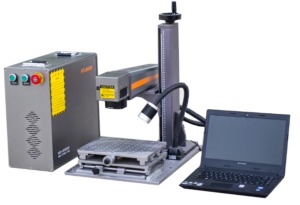Is Fiber Laser Engraving Good Option for Mold Engraving – Alex
[av_textblock size=” font_color=” color=”]
Fiber laser marking and fiber laser engraving technologies are emerging in the mold making industry. Mold makers know that machining small cavities in molds is difficult and time consuming, and extensive hand polishing is usually needed to complete the job. The task is made more difficult if the mold has already been hardened or made from pre-hardened steel.
Deep laser engraving provides an alternative non-contact machining process that is effective on hardened tool steels and able to access difficult to reach locations. It complements traditional CNC milling and electrical discharge machining (EDM) processes.

What Is Deep Fiber Laser Engraving?
Deep fiber laser engraving is generally considered to be a machining process that removes up to 30 thousandths of an inch of material. It is frequently used to add detail to molds such as patterns and features or to add identification marks. It’s different from laser marking in that material is removed from the surface of the material.
Laser engraving uses higher powered fiber laser systems that are typically used for laser marking and fiber laser engraving. The system uses engraving software as well as a range of motion control devices for precise control, and has the ability to engrave flat and contoured surfaces.
Application in Molds
The major benefit of fiber laser engraving solutions is that it will work wherever there is line of sight to the point to be marked. If you need to put identification marks at the bottom of a tool for making a plastic pin, it’s a relatively simple task to mount the mold in the laser and make the laser engraving. Deep laser engraving can be used for small and complex parts that are impossible to reach with mechanical engraving equipment.
Comparable Processes
A significant benefit of using lasers for engraving molds is that it works equally well on hardened steel surfaces. In this context, it has similar properties to EDM, also known as spark eroding. However, it’s generally faster, easier to set up, and requires no expensive consumables such as electrolyte and electrodes.
On the other hand, if the volume of material to be removed is significant, then conventional CNC milling may be faster and or more effective.
Benefits of Laser Engraving
Deep laser engraving can reduce costs and expand the scope of work performed by tool and die makers. Some of the benefits of laser engraving include:
- Replace milling and EDM machines: Laser engraving can replace conventional machining methods for small cavities and reduce overall mold costs.
- Long life: Laser components last longer and require less maintenance than EDM and CNC milling machines.
- Surface finish: Laser engraving gives a better surface finish that usually does not require hand polishing.
- Heat-affected zone: Laser engraving has a lower impact on the surface hardness of molds and avoids the risk of micro-fracturing that exists with EDM.
- Cost: Running costs are much lower.
Limitations of Laser Engraving
To a large degree, laser engraving complements rather than replaces EDM. The choice depends on the amount of machining needed and the mold design. Likewise, lasers cannot replace a milling machine that has a higher material removal capacity.
[/av_textblock]
[av_textblock size=” font_color=” color=”]
Contact Information:
Email: xintian104@xtlaser.com
Skype: saint512406
Mobile&whatsapp : 0086 18766152065
Web: www.xtlaser.com
[/av_textblock]



